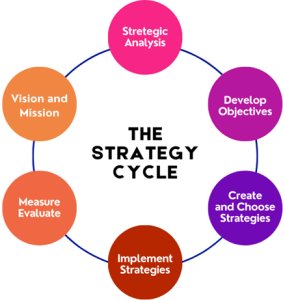7.4. The Strategic Management Process
The strategic management process encompasses the series of activities that managers undertake to position their organizations effectively for competitive success (Firdaus & Kanyan, 2014).
The strategic management process involves several key activities that collectively contribute to developing and maintaining a strong competitive position. This section will delve into each of these activities and their roles in shaping a successful strategy.

Fig 7.2. The Strategy Cycle
While Figure 7.2 illustrates strategic management as a sequential process, in practice, top managers often handle multiple aspects simultaneously. They engage in environmental scanning to keep their understanding of the competitive landscape current, implement strategies formulated in the past and develop new strategies for future execution. This overlapping nature of the process means that various elements are continuously in motion, rather than following a strict step-by-step sequence.
A marketing strategy involves selecting and analyzing a target market and developing a suitable marketing mix to satisfy that market (Pride & Ferrell, 1997). It should be as detailed as possible. For instance, to boost dessert sales, a vague strategy like “Advertising the addition of low-fat frozen yogurt to the menu” is inadequate. A more effective strategy would be, “Increase dessert sales by 10% within 3 months by adding low-fat frozen yogurt to the menu and intensifying advertising efforts towards health-conscious consumers.”
This marketing strategy is carried out through a series of tactics, which are specific actions. While the strategy outlines how to attract and retain customers, tactics provide the step-by-step procedures to achieve this. For example, if the objective is “to be perceived as the restaurant of choice,” the strategy might be “to offer customers better value.” Tactics to support this could include ensuring tables are ready for customers with reservations, addressing customers by name, making menus easy to read and providing options for those with special dietary needs. Tactics are derived from the strategy, highlighting the need for a well-developed strategy first.
Monitoring results demands comparing performance standards with actual performance over a set period. Tools such as budgets, timetables and sales and cost analyses may be used to assess outcomes. If actual performance falls short of standards, corrective actions should be taken. Many organizations prepare contingency plans to address any deficiencies in meeting performance standards. ([Author removed at request of original publisher], 2015)
Media Attributions
- Picture3

